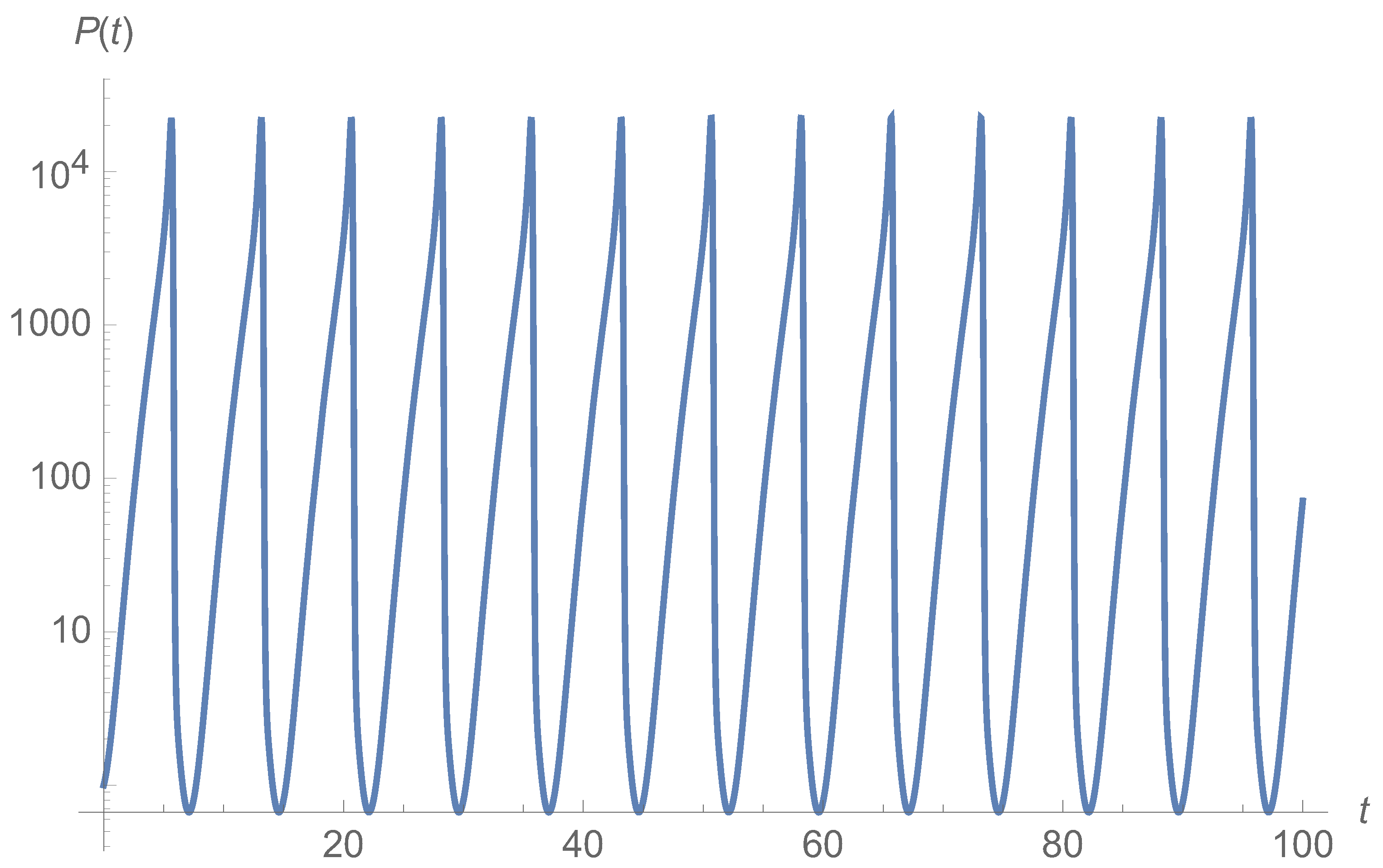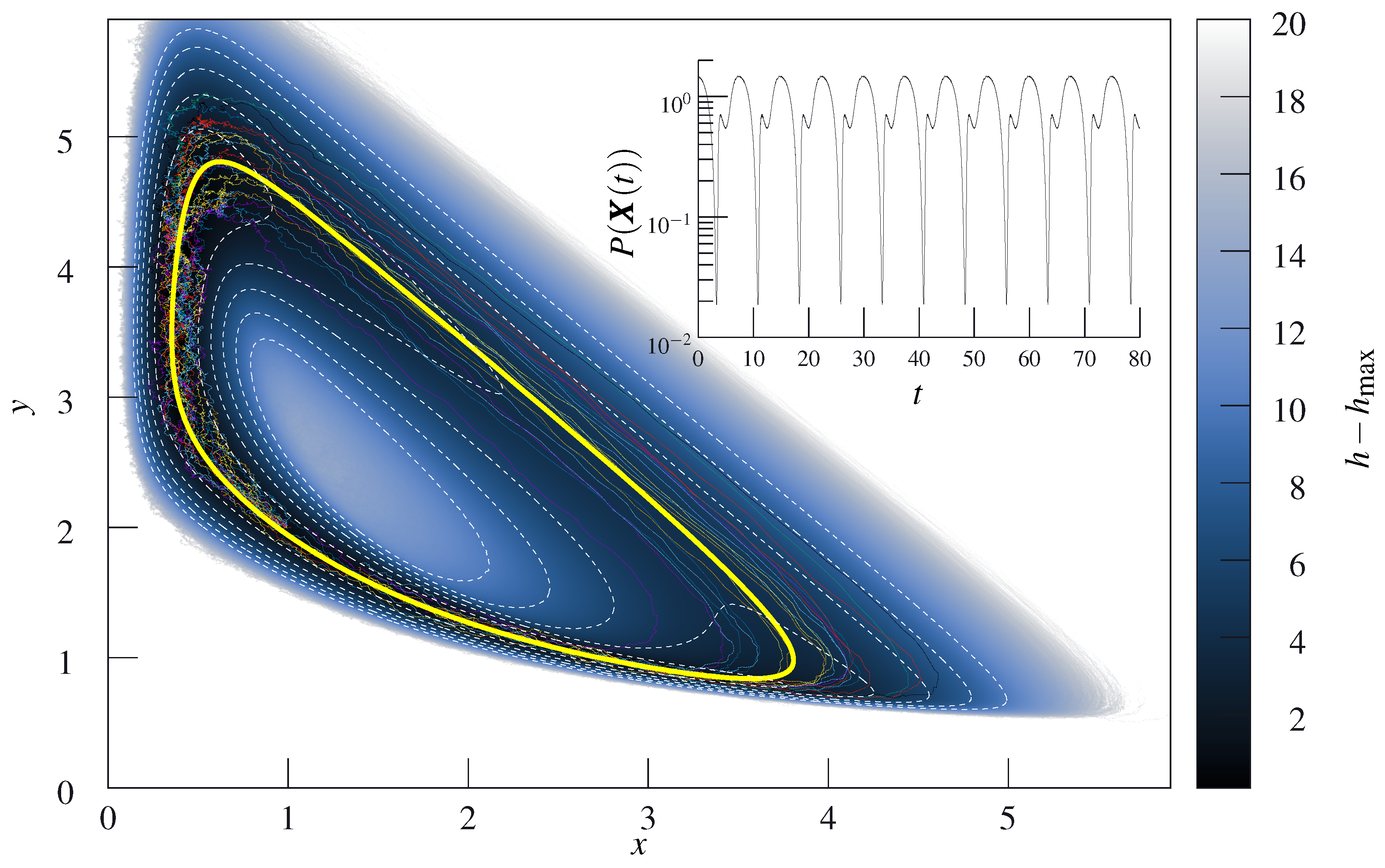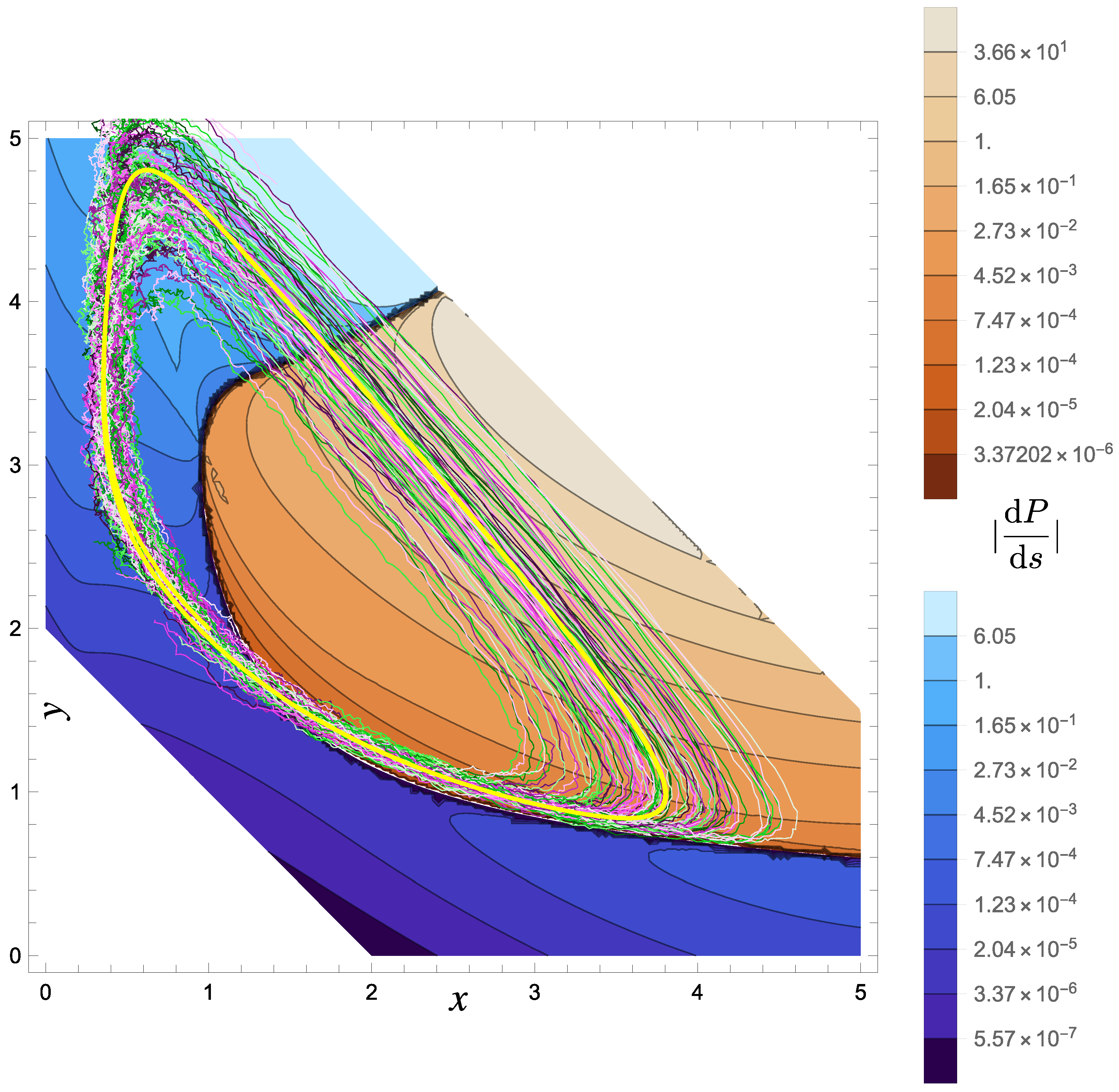Nonequilibrium Steady States in Active Systems: A Helmholtz–Hodge Perspective
Abstract
1. Introduction
2. The Langevin Equation: Terms and Definitions
3. Fokker–Planck Equation
Inertial Systems
4. Mapping to a Liouville Equation: Typical Trajectories
5. Discussion
Author Contributions
Funding
Institutional Review Board Statement
Data Availability Statement
Acknowledgments
Conflicts of Interest
References
- Ramaswamy, S. The Mechanics and Statistics of Active Matter. Annu. Rev. Condens. Matter Phys. 2010, 1, 323–345. [Google Scholar] [CrossRef]
- Granek, O.; Kafri, Y.; Kardar, M.; Ro, S.; Tailleur, J.; Solon, A. Colloquium: Inclusions, boundaries, and disorder in scalar active matter. Rev. Mod. Phys. 2024, 96, 031003. [Google Scholar] [CrossRef]
- Te Vrugt, M.; Wittkowski, R. Metareview: A survey of active matter reviews. Eur. Phys. J. E 2025, 48, 12. [Google Scholar] [PubMed]
- Lebowitz, J.L.; Bergmann, P.G. Irreversible gibbsian ensembles. Ann. Phys. 1957, 1, 1–23. [Google Scholar] [CrossRef]
- Temperley, H. The Statistical Mechanics of the Steady State. Proc. Phys. Soc. Sect. B 1957, 70, 577. [Google Scholar] [CrossRef]
- Lebowitz, J.L. Stationary Nonequilibrium Gibbsian Ensembles. Phys. Rev. 1959, 114, 1192. [Google Scholar] [CrossRef]
- McLennan, J.A., Jr. Statistical mechanics of the steady state. Phys. Rev. 1959, 115, 1405. [Google Scholar] [CrossRef]
- Haken, H. Exact generalized Fokker-Planck equation for arbitrary dissipative and nondissipative quantum-systems. Z Phys. 1969, 219, 411–433. [Google Scholar] [CrossRef]
- Graham, R. Quantentheorie der Lichtausbreitung in Laser-Aktiven Fluktuierenden Medien. Ph.D. Thesis, University Stuttgart, Stuttgart, Germany, 1969. [Google Scholar]
- Graham, R.; Haken, H. Generalized thermodynamic potential for Markoff systems in detailed balance and far from thermal equilibrium. Z Phys. 1971, 243, 289–302. [Google Scholar] [CrossRef]
- Graham, R.; Tél, T. Existence of a potential for dissipative dynamical systems. Phys. Rev. Lett. 1984, 52, 9. [Google Scholar] [CrossRef]
- Gallavotti, G.; Cohen, E.G.D. Dynamical Ensembles in Nonequilibrium Statistical Mechanics. Phys. Rev. Lett. 1995, 74, 2694. [Google Scholar] [CrossRef]
- Eyink, G.L.; Lebowitz, J.L.; Spohn, H. Hydrodynamics and fluctuations outside of local equilibrium: Driven diffusive systems. J. Stat. Phys. 1996, 83, 385–472. [Google Scholar] [CrossRef]
- Balents, L.; Marchetti, M.C.; Radzihovsky, L. Nonequilibrium steady states of driven periodic media. Phys. Rev. B 1998, 57, 7705–7739. [Google Scholar] [CrossRef]
- Ruelle, D. Smooth dynamics and new theoretical ideas in nonequilibrium statistical mechanics. J. Stat. Phys. 1999, 95, 393–468. [Google Scholar] [CrossRef]
- Eckmann, J.P. Non-equilibrium steady states. arXiv 2003, arXiv:math-ph/0304043. [Google Scholar]
- Zia, R.K.P.; Schmittmann, B. A possible classification of nonequilibrium steady states. J. Phys. Math. Gen. 2006, 39, L407. [Google Scholar] [CrossRef]
- Sasa, S.I.; Tasaki, H. Steady state thermodynamics. J. Stat. Phys. 2006, 125, 125–224. [Google Scholar] [CrossRef]
- Derrida, B. Non-equilibrium steady states: Fluctuations and large deviations of the density and of the current. J. Stat. Mech. Theory Exp. 2007, 2007, P07023. [Google Scholar] [CrossRef]
- Maes, C.; Netočný, K. Rigorous meaning of McLennan ensembles. J. Math. Phys. 2010, 51, 015219. [Google Scholar] [CrossRef]
- Seifert, U. Stochastic thermodynamics, fluctuation theorems and molecular machines. Rep. Prog. Phys. 2012, 75, 126001. [Google Scholar] [CrossRef]
- Wang, J. Landscape and flux theory of non-equilibrium dynamical systems with application to biology. Adv. Phys. 2015, 64, 1–137. [Google Scholar] [CrossRef]
- Maggi, C.; Marconi, U.M.B.; Gnan, N.; Leonardo, R.D. Multidimensional stationary probability distribution for interacting active particles. Sci. Rep. 2015, 5, 10742. [Google Scholar] [CrossRef]
- Sano, M.M. The McLennan-Zubarev steady state distribution and fluctuation theorems. Phys. A-Stat. Mech. Its Appl. 2017, 473, 603–619. [Google Scholar] [CrossRef]
- Martin, D.; O’Byrne, J.; Cates, M.E.; Fodor, E.; Nardini, C.; Tailleur, J.; Wijland, F.V. Statistical mechanics of active Ornstein-Uhlenbeck particles. Phys. Rev. E 2021, 103, 032607. [Google Scholar] [CrossRef] [PubMed]
- Van Kampen, N.G. Stochastic Processes in Physics and Chemistry; Elsevier: Amsterdam, The Netherlands, 1992; Volume 1. [Google Scholar]
- Gnesotto, F.S.; Mura, F.; Gladrow, J.; Broedersz, C.P. Broken detailed balance and non-equilibrium dynamics in living systems: A review. Rep. Prog. Phys. 2018, 81, 066601. [Google Scholar] [CrossRef]
- Toner, J. The Physics of Flocking; Cambridge University Press: Cambridge, UK, 2024. [Google Scholar]
- Chaté, H. Dry Aligning Dilute Active Matter. Annu. Rev. Condens. Matter Phys. 2020, 11, 189–212. [Google Scholar] [CrossRef]
- Fang, X.; Kruse, K.; Lu, T.; Wang, J. Nonequilibrium physics in biology. Rev. Mod. Phys. 2019, 91, 045004. [Google Scholar] [CrossRef]
- Ge, H.; Qian, H. Landscapes of non-gradient dynamics without detailed balance: Stable limit cycles and multiple attractors. Chaos Interdiscip. J. Nonlinear Sci. 2012, 22, 023140. [Google Scholar] [CrossRef]
- Wio, H.; Deza, J.; Sánchez, A.; García-García, R.; Gallego, R.; Revelli, J.; Deza, R. The nonequilibrium potential today: A short review. Chaos Solitons Fractals 2022, 165, 112778. [Google Scholar] [CrossRef]
- Dorfman, J.R.; van Beijeren, H.; Kirkpatrick, T.R. Contemporary Kinetic Theory of Matter; Cambridge University Press: Cambridge, UK, 2021. [Google Scholar]
- Boltz, H.H.; Kohler, B.; Ihle, T. Kinetic Theory of Self-Propelled Particles with Nematic Alignment. Entropy 2024, 26, 1054. [Google Scholar] [CrossRef]
- Zhou, J.X.; Aliyu, M.; Aurell, E.; Huang, S. Quasi-potential landscape in complex multi-stable systems. J. R. Soc. Interface 2012, 9, 3539–3553. [Google Scholar] [CrossRef]
- Nelson, E. Dynamical Theories of Brownian Motion; Princeton University Press: Princeton, NJ, USA, 1967. [Google Scholar]
- Liverpool, T.B. Steady-state distributions and nonsteady dynamics in nonequilibrium systems. Phys. Rev. E 2020, 101, 042107. [Google Scholar] [CrossRef]
- Maoutsa, D.; Reich, S.; Opper, M. Interacting Particle Solutions of Fokker–Planck Equations Through Gradient–Log–Density Estimation. Entropy 2020, 22, 802. [Google Scholar] [CrossRef]
- Boffi, N.M.; Vanden-Eijnden, E. Deep learning probability flows and entropy production rates in active matter. Proc. Natl. Acad. Sci. USA 2024, 121, e2318106121. [Google Scholar] [CrossRef] [PubMed]
- Suda, T. Construction of Lyapunov functions using Helmholtz–Hodge decomposition. Discret. Contin. Dyn. Syst. 2019, 39, 2437–2454. [Google Scholar] [CrossRef]
- Suda, T. Application of Helmholtz–Hodge decomposition to the study of certain vector fields. J. Phys. A Math. Theor. 2020, 53, 375703. [Google Scholar] [CrossRef]
- Teschl, G. Ordinary Differential Equations and Dynamical Systems; American Mathematical Soc.: Providence, RI, USA, 2012; Volume 140. [Google Scholar]
- Glötzl, E.; Richters, O. Helmholtz decomposition and potential functions for n-dimensional analytic vector fields. J. Math. Anal. Appl. 2023, 525, 127138. [Google Scholar] [CrossRef]
- Morales-Moya, L.J. Geometric decomposition of planar vector fields with a limit cycle. arXiv 2024, arXiv:2408.10220. [Google Scholar]
- Ao, P. Potential in stochastic differential equations: Novel construction. J. Phys. A Math. Gen. 2004, 37, L25. [Google Scholar] [CrossRef]
- Xing, J. Mapping between dissipative and Hamiltonian systems. J. Phys. A Math. Theor. 2010, 43, 375003. [Google Scholar] [CrossRef]
- Yuan, R.; Tang, Y.; Ao, P. SDE decomposition and A-type stochastic interpretation in nonequilibrium processes. Front. Phys. 2017, 12, 1–9. [Google Scholar] [CrossRef]
- Yuan, R.; Ao, P. Beyond itô versus stratonovich. J. Stat. Mech. Theory Exp. 2012, 2012, P07010. [Google Scholar] [CrossRef]
- Qian, H. A decomposition of irreversible diffusion processes without detailed balance. J. Math. Phys. 2013, 54, 053302. [Google Scholar] [CrossRef]
- Risken, H. The Fokker-Planck Equation; Springer: Berlin/Heidelberg, Germany, 1996. [Google Scholar]
- Gardiner, C. Stochastic Methods; Springer: Berlin/Heidelberg, Germany, 2009; Volume 4. [Google Scholar]
- Maes, C. Fluctuations and Response Out-of-Equilibrium. Prog. Theor. Phys. Suppl. 2010, 184, 318–328. [Google Scholar] [CrossRef]
- Komatsu, T.; Nakagawa, N. Expression for the Stationary Distribution in Nonequilibrium Steady States. Phys. Rev. Lett. 2008, 100, 030601. [Google Scholar] [CrossRef]
- Komatsu, T.; Nakagawa, N.; Sasa, S.I.; Tasaki, H. Representation of Nonequilibrium Steady States in Large Mechanical Systems. J. Stat. Phys. 2009, 134, 401–423. [Google Scholar] [CrossRef]
- Colangeli, M.; Maes, C.; Wynants, B. A meaningful expansion around detailed balance. J. Phys. A 2011, 44, 095001. [Google Scholar] [CrossRef]
- Wittmann, R.; Maggi, C.; Sharma, A.; Scacchi, A.; Brader, J.M.; Marconi, U.M.B. Effective equilibrium states in the colored-noise model for active matter I. Pairwise forces in the Fox and unified colored noise approximations. J. Stat. Mech. Theory Exp. 2017, 11, 113207. [Google Scholar] [CrossRef]
- Wittmann, R.; Marconi, U.; Maggi, C.; Brader, J.M. Effective equilibrium states in the colored-noise model for active matter II. A unified framework for phase equilibria, structure and mechanical properties. J. Stat. Mech. Theory Exp. 2017, 11, 113208. [Google Scholar] [CrossRef]
- Lesnicki, D.; Gao, C.Y.; Limmer, D.T.; Rotenberg, B. On the molecular correlations that result in field-dependent conductivities in electrolyte solutions. J. Chem. Phys. 2021, 155, 014507. [Google Scholar] [CrossRef]
- Freitas, N.; Falasco, G.; Esposito, M. Linear response in large deviations theory: A method to compute non-equilibrium distributions. New J. Phys. 2021, 23, 093003. [Google Scholar] [CrossRef]
- Fiori, E.R.; Maes, C. Heat capacity of periodically driven two-level systems. Phys. Rev. E 2024, 110, 024121. [Google Scholar] [CrossRef] [PubMed]
- Michel, M.; Kapfer, S.C.; Krauth, W. Generalized event-chain Monte Carlo: Constructing rejection-free global-balance algorithms from infinitesimal steps. J. Chem. Phys. 2014, 140, 054116. [Google Scholar] [CrossRef]
- Harland, J.; Michel, M.; Kampmann, T.A.; Kierfeld, J. Event-chain Monte Carlo algorithms for three- and many-particle interactions. Europhys. Lett. 2017, 117, 30001. [Google Scholar] [CrossRef]
- Klamser, J.U.; Dauchot, O.; Tailleur, J. Kinetic Monte Carlo Algorithms for Active Matter Systems. Phys. Rev. Lett. 2021, 127, 150602. [Google Scholar] [CrossRef] [PubMed]
- Cugliandolo, L.F. The effective temperature. J. Phys. A Math. Theor. 2011, 44, 483001. [Google Scholar] [CrossRef]
- Szamel, G. Self-propelled particle in an external potential: Existence of an effective temperature. Phys. Rev. E 2014, 90, 012111. [Google Scholar] [CrossRef]
- Tel, T.; Graham, R.; Hu, G. Nonequilibrium potentials and their power-series expansions. Phys. Rev. A 1989, 40, 4065. [Google Scholar] [CrossRef]
- Baek, Y.; Kafri, Y. Singularities in large deviation functions. J. Stat. Mech. Theory Exp. 2015, 2015, P08026. [Google Scholar] [CrossRef]
- Golestanian, R. Dancing Is Allowed in Steady States, 2019. Comment in the Journal Club for Condensed Matter Physics. Available online: https://www.condmatjclub.org/dancing-is-allowed-in-steady-states/ (accessed on 10 May 2025).
- Cameron, S.; Mosayebi, M.; Bennett, R.; Liverpool, T.B. Equation of state for active matter. Phys. Rev. E 2023, 108, 014608. [Google Scholar] [CrossRef]
- Cates, M.E.; Tailleur, J. Motility-induced phase separation. Annu. Rev. Condens. Matter Phys. 2015, 6, 219–244. [Google Scholar] [CrossRef]
- Kreuzer, H.J. Non Equilibrium Thermodynamics and its Statistical Foundations; Claredon: Oxford, UK, 1981. [Google Scholar]
- Ihle, T.; Kürsten, R.; Lindner, B. Asymptotically exact scattering theory of active particles with anti-alignment interactions. arXiv 2023, arXiv:2303.03357. [Google Scholar]
- Ihle, T.; Kürsten, R.; Lindner, B. Scattering theory of Non-Brownian active particles with social distancing. arXiv 2023, arXiv:2303.03354. [Google Scholar]
- Fodor, E.; Nardini, C.; Cates, M.E.; Tailleur, J.; Visco, P.; Wijland, F.V. How Far from Equilibrium Is Active Matter? Phys. Rev. Lett. 2016, 117, 038103. [Google Scholar] [CrossRef]
- GrandPre, T.; Klymko, K.; Mandadapu, K.K.; Limmer, D.T. Entropy production fluctuations encode collective behavior in active matter. Phys. Rev. E 2021, 103, 012613. [Google Scholar] [CrossRef]
- Itami, M.; Sasa, S.I. Universal form of stochastic evolution for slow variables in equilibrium systems. J. Stat. Phys. 2017, 167, 46–63. [Google Scholar] [CrossRef]
- De Pirey, T.A.; Cugliandolo, L.F.; Lecomte, V.; Van Wijland, F. Path integrals and stochastic calculus. Adv. Phys. 2022, 71, 1–85. [Google Scholar] [CrossRef]
- Hänggi, P. Connection between deterministic and stochastic descriptions of nonlinear systems. Helv. Phys. Acta 1980, 53. [Google Scholar] [CrossRef]
- Klimontovich, Y.L. Ito, Stratonovich and kinetic forms of stochastic equations. Phys. A Stat. Mech. Its Appl. 1990, 163, 515–532. [Google Scholar] [CrossRef]
- Gaspard, P. Trace formula for noisy flows. J. Stat. Phys. 2002, 106, 57–96. [Google Scholar] [CrossRef]
- Bouchet, F.; Gawedzki, K.; Nardini, C. Perturbative calculation of quasi-potential in non-equilibrium diffusions: A mean-field example. J. Stat. Phys. 2016, 163, 1157–1210. [Google Scholar] [CrossRef]
- Falasco, G.; Esposito, M. Macroscopic stochastic thermodynamics. Rev. Mod. Phys. 2025, 97, 015002. [Google Scholar] [CrossRef]
- Freidlin, M.I.; Wentzell, A.D. Random Perturbations of Dynamical Systems; Grundlehren Der Mathematischen Wissenschaften; Springer: New York, NY, USA, 1984; Volume 260. [Google Scholar] [CrossRef]
- Anishchenko, V.S.; Vadivasova, T.E.; Okrokvertskhov, G.A.; Strelkova, G.I. Statistical properties of dynamical chaos. Phys. Uspekhi 2005, 48, 151. [Google Scholar] [CrossRef]
- Bröker, S.; Bickmann, J.; te Vrugt, M.; Cates, M.E.; Wittkowski, R. Orientation-Dependent Propulsion of Active Brownian Spheres: From Self-Advection to Programmable Cluster Shapes. Phys. Rev. Lett. 2023, 131, 168203. [Google Scholar] [CrossRef]



Disclaimer/Publisher’s Note: The statements, opinions and data contained in all publications are solely those of the individual author(s) and contributor(s) and not of MDPI and/or the editor(s). MDPI and/or the editor(s) disclaim responsibility for any injury to people or property resulting from any ideas, methods, instructions or products referred to in the content. |
© 2025 by the authors. Licensee MDPI, Basel, Switzerland. This article is an open access article distributed under the terms and conditions of the Creative Commons Attribution (CC BY) license (https://creativecommons.org/licenses/by/4.0/).
Share and Cite
Boltz, H.-H.; Ihle, T. Nonequilibrium Steady States in Active Systems: A Helmholtz–Hodge Perspective. Entropy 2025, 27, 525. https://doi.org/10.3390/e27050525
Boltz H-H, Ihle T. Nonequilibrium Steady States in Active Systems: A Helmholtz–Hodge Perspective. Entropy. 2025; 27(5):525. https://doi.org/10.3390/e27050525
Chicago/Turabian StyleBoltz, Horst-Holger, and Thomas Ihle. 2025. "Nonequilibrium Steady States in Active Systems: A Helmholtz–Hodge Perspective" Entropy 27, no. 5: 525. https://doi.org/10.3390/e27050525
APA StyleBoltz, H.-H., & Ihle, T. (2025). Nonequilibrium Steady States in Active Systems: A Helmholtz–Hodge Perspective. Entropy, 27(5), 525. https://doi.org/10.3390/e27050525





